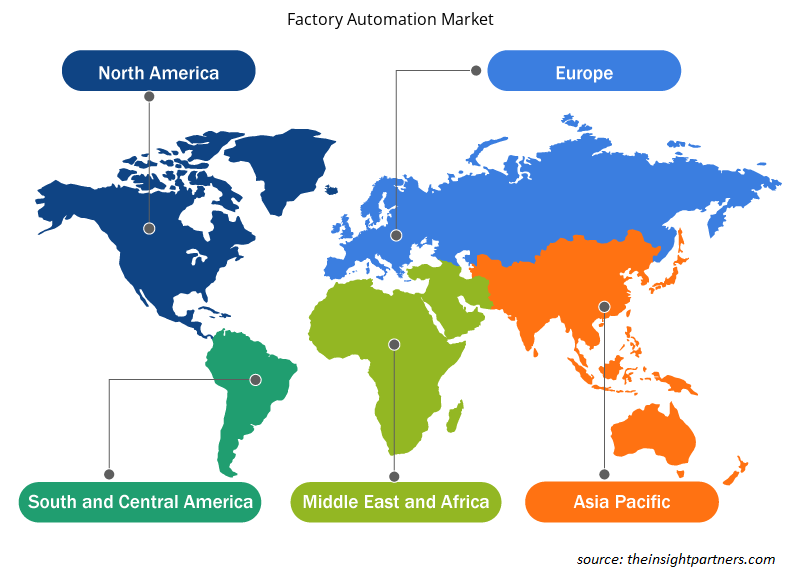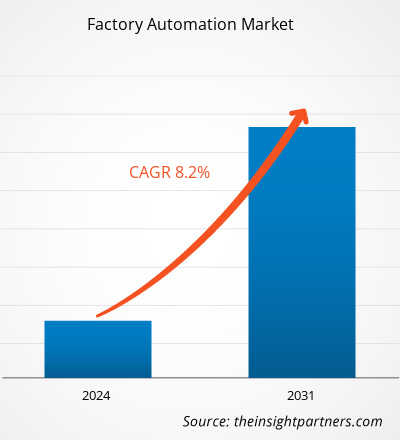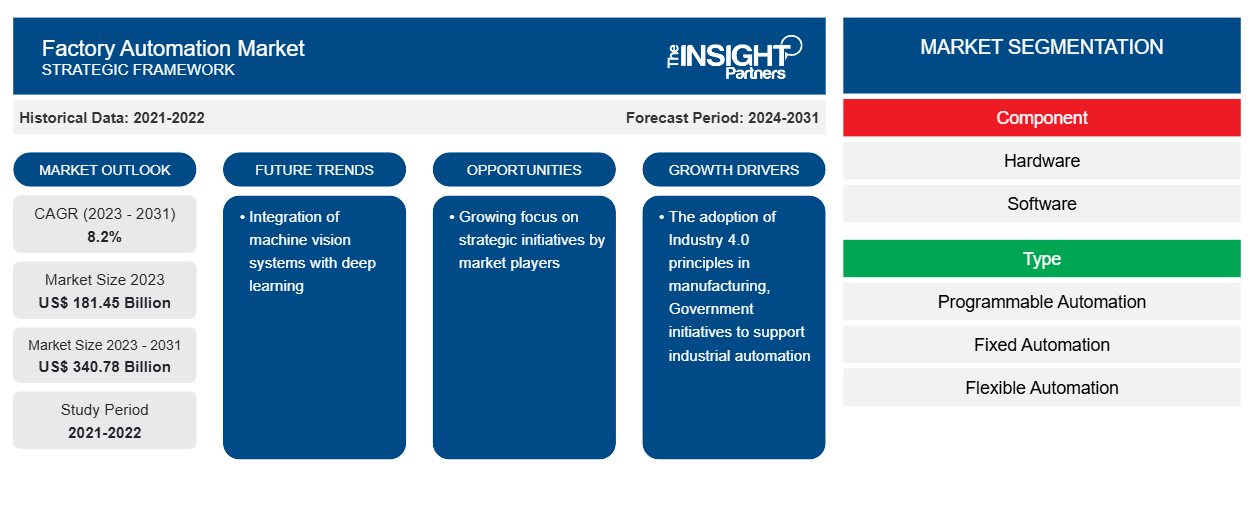ファクトリーオートメーション市場は、2023 年の 1,814.5 億米ドルから 2031 年には 3,407.8 億米ドルに成長すると予測されており、2023 年から 2031 年にかけて 8.2% の CAGR で拡大すると予想されています。マシンビジョンシステムとディープラーニングの統合は、市場の主要なトレンドになると予想されています。
ファクトリーオートメーション市場分析
製造業は過去 10 年間で急速に拡大しました。グローバル化によって市場が拡大し、多数の新規参入者が参入しています。主要企業の工場自動化市場における競争上の優位性は、製品の差別化、コストリーダーシップ、ターゲットマーケティング、優れたアフターサービスを通じて構築できます。自動化は生産プロセスにとって重要な要素です。さらに、高度な自動化ソリューションにより、一貫して高品質、高スループット、低生産コストを実現できます。したがって、工場自動化市場は予測期間中に成長すると予想されます。
ファクトリーオートメーション市場業界概要
ファクトリーオートメーションとは、製造プロセスのすべての段階にオートメーションを統合することです。製造におけるオートメーションでは、空気圧システム、油圧システム、ロボットアームなどの技術を組み合わせて、より複雑なシステムを作り出すことがよくあります。競争の激しい環境では、ファクトリーオートメーションは、コストを削減しながら生産量と効率を向上させるのに役立ちます。ファクトリーオートメーションは、急速に変化する現代の工場環境において、効率、品質、持続可能性、安全性、セキュリティを向上させる魅力的な方法を提供します。
要件に合わせてレポートをカスタマイズする
このレポートの一部、国レベルの分析、Excelデータパックなど、あらゆるレポートを無料でカスタマイズできます。また、スタートアップや大学向けのお得なオファーや割引もご利用いただけます。
-
このレポートの主要な市場動向を入手してください。この無料サンプルには、市場動向から見積もりや予測に至るまでのデータ分析が含まれます。
ファクトリーオートメーション市場の推進要因と機会
市場の成長を促進するために製造業にインダストリー 4.0 の原則を採用します。
第 4 次産業革命 (インダストリー 4.0) の革命的な力は、世界の生産を変えています。インダストリー 4.0 は、インテリジェント システム、人工知能 (AI)、ビッグ データ、高度な IT アーキテクチャによって (部分的に) 定義され、製造業全体の進化における次のステップを表しており、多くの企業がこれらのテクノロジを採用しています。インダストリー 4.0 のプロセス、テクノロジ、システムの利点には、生産性と効率性の向上、俊敏性と柔軟性の向上、収益性の向上などがあります。したがって、多くの業界での自動化のためのインダストリー 4.0 の採用は、予測期間中に工場自動化市場の成長を促進すると予想されます。
市場参加者による戦略的取り組みへの注目が高まる
主要な市場参加者が合併、買収、コラボレーションなどの戦略的活動にますます重点を置くようになり、ファクトリーオートメーション市場の成長が加速すると予想されています。たとえば、2021年7月、産業オートメーションとデジタルトランスフォーメーションに取り組むRockwell Automation, Inc.は、大手クラウドネイティブスマート製造プラットフォームであるPlex Systemsの買収を発表しました。さらに、2021年9月、Rockwell Automation, Inc.は、クラウドベースの製品デジタル化およびトレーサビリティプラットフォームであるKezzlerとの提携を発表し、製品トレーサビリティに重点を置いたクラウドベースのサプライチェーンソリューションを使用して、製造業者が原材料源から販売時点またはそれ以降の製品の経路を把握できるように支援します。
ファクトリーオートメーション市場レポートのセグメンテーション分析
ファクトリーオートメーション市場分析の導出に貢献した主要なセグメントは、コンポーネント、タイプ、テクノロジー、および業界垂直です。
- コンポーネントに基づいて、市場はハードウェアとソフトウェアに分かれています
- タイプに基づいて、市場はプログラム可能な自動化、固定自動化、柔軟な自動化に分かれています。
- 技術に基づいて、市場はプログラマブルロジックコントローラー (PLC)、分散制御システム (DCS)、監視制御およびデータ収集システム (SCADA)、ヒューマンマシンインターフェース (HMI)、その他に分類されます。
- 業界別では、市場は自動車、食品・飲料、石油・ガス、製造、鉱業、その他に分類されます。
地域別ファクトリーオートメーション市場シェア分析
地域に基づいて、市場は北米、ヨーロッパ、アジア太平洋、中東およびアフリカ、南米および中米に分割されています。
北米は、予測期間中にファクトリーオートメーション市場で大きなシェアを占めると予想されています。この成長は、早期の技術導入と研究開発活動への重点的な取り組みに起因する可能性があります。さらに、協働ロボットの人気の高まりと、業界全体にわたるデジタル変革に向けた政府の取り組みにより、予測期間中にファクトリーオートメーション市場が活性化すると予想されます。
ファクトリーオートメーション市場の地域別洞察
予測期間を通じてファクトリーオートメーション市場に影響を与える地域的な傾向と要因は、Insight Partners のアナリストによって徹底的に説明されています。このセクションでは、北米、ヨーロッパ、アジア太平洋、中東およびアフリカ、南米および中米にわたるファクトリーオートメーション市場のセグメントと地理についても説明します。

- ファクトリーオートメーション市場の地域別データを入手
ファクトリーオートメーション市場レポートの範囲
| レポート属性 | 詳細 |
|---|---|
| 2023年の市場規模 | 1,814.5億米ドル |
| 2031年までの市場規模 | 3,407.8億米ドル |
| 世界のCAGR(2023年~2031年) | 8.2% |
| 履歴データ | 2021-2022 |
| 予測期間 | 2024-2031 |
| 対象セグメント |
コンポーネント別
|
| 対象地域と国 |
北米
|
| 市場リーダーと主要企業プロフィール |
|
ファクトリーオートメーション市場のプレーヤー密度:ビジネスダイナミクスへの影響を理解する
ファクトリーオートメーション市場は、消費者の嗜好の変化、技術の進歩、製品の利点に対する認識の高まりなどの要因により、エンドユーザーの需要が高まり、急速に成長しています。需要が高まるにつれて、企業は提供を拡大し、消費者のニーズを満たすために革新し、新たなトレンドを活用し、市場の成長をさらに促進しています。
市場プレーヤー密度とは、特定の市場または業界内で活動している企業または会社の分布を指します。これは、特定の市場スペースに、その市場規模または総市場価値に対してどれだけの競合相手 (市場プレーヤー) が存在するかを示します。
ファクトリーオートメーション市場で事業を展開している主要企業は次のとおりです。
- ABB株式会社
- エマーソンエレクトリック社
- ファナック株式会社
- ゼネラル・エレクトリック・カンパニー
- 三菱電機株式会社
- ハネウェルインターナショナル株式会社
免責事項:上記の企業は、特定の順序でランク付けされていません。

- ファクトリーオートメーション市場のトップキープレーヤーの概要を入手
ファクトリーオートメーション市場のニュースと最近の動向
ファクトリーオートメーション市場は、主要な企業出版物、協会データ、データベースなどの一次調査と二次調査を経て定性的および定量的データを収集することで評価されます。ファクトリーオートメーションのいくつかの動向を以下に示します。
- 三菱電機は、子会社の三菱電機インド社に約22億インドルピー(約31億円)を投じ、インドに新工場を設立すると発表した。2023年12月に稼働開始予定の新工場では、インバーターなどのファクトリーオートメーション(FA)制御システム製品を生産し、インドでの需要拡大に対応するための能力を拡大する。(出典:三菱電機、プレスリリース、2022年6月)
ファクトリーオートメーション市場レポートのカバレッジと成果物
ファクトリーオートメーション市場の予測は、主要な企業の出版物、協会データ、データベースなど、さまざまな二次および一次調査結果に基づいて推定されています。市場レポート「ファクトリーオートメーション市場の規模と予測(2021〜2031年)」では、以下の分野をカバーする市場の詳細な分析を提供しています。
- 対象範囲に含まれるすべての主要市場セグメントについて、世界、地域、国レベルでのファクトリーオートメーション市場の規模と予測
- ファクトリーオートメーション市場の動向、および推進要因、制約、主要な機会などの市場動向
- 詳細なPEST/ポーターの5つの力とSWOT分析
- 主要な市場動向、世界および地域の枠組み、主要プレーヤー、規制、最近の市場動向を網羅したファクトリーオートメーション市場分析
- 市場集中、ヒートマップ分析、主要プレーヤー、ファクトリーオートメーション市場の最近の動向を網羅した業界の状況と競争分析
- 詳細な企業プロフィール。
- 過去2年間の分析、基準年、CAGRによる予測(7年間)
- PEST分析とSWOT分析
- 市場規模価値/数量 - 世界、地域、国
- 業界と競争環境
- Excel データセット
最新レポート
お客様の声
購入理由
- 情報に基づいた意思決定
- 市場動向の理解
- 競合分析
- 顧客インサイト
- 市場予測
- リスク軽減
- 戦略計画
- 投資の正当性
- 新興市場の特定
- マーケティング戦略の強化
- 業務効率の向上
- 規制動向への対応























 無料サンプルを入手 - ファクトリーオートメーション市場
無料サンプルを入手 - ファクトリーオートメーション市場